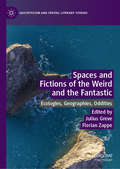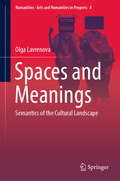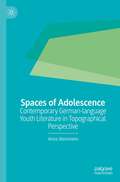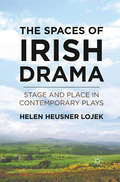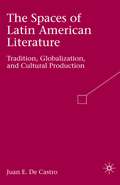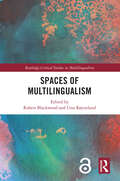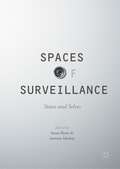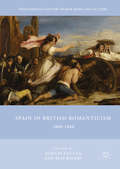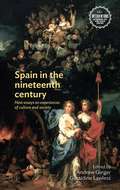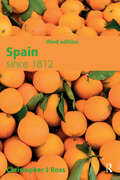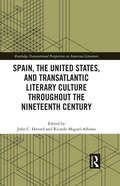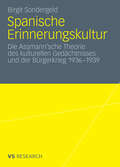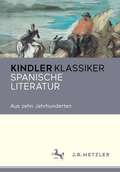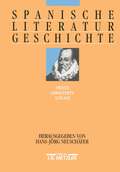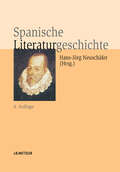- Table View
- List View
Spacecraft (Object Lessons)
by Timothy MortonScience fiction is filled with spacecraft. On Earth, actual rockets explode over Texas while others make their way to Mars. But what are spacecraft, and just what can they teach us about imagination, ecology, democracy, and the nature of objects? Why do certain spacecraft stand out in popular culture?If ever there were a spacecraft that could be detached from its context, sold as toys, turned into Disney rides, parodied, and flit around in everyone's head-the Millennium Falcon would be it. Springing from this infamous Star Wars vehicle, Spacecraft takes readers on an intergalactic journey through science fiction and speculative philosophy, revealing real-world political and ecological lessons along the way. In this book Timothy Morton shows how spacecraft are never mere flights of fancy.
Spaces and Fictions of the Weird and the Fantastic: Ecologies, Geographies, Oddities (Geocriticism and Spatial Literary Studies)
by Julius Greve Florian ZappeThis collection of essays discusses genre fiction and film within the discursive framework of the environmental humanities and analyses the convergent themes of spatiality, climate change, and related anxieties concerning the future of human affairs, as crucial for any understanding of current forms of “weird” and “fantastic” literature and culture. Given their focus on the culturally marginal, unknown, and “other,” these genres figure as diagnostic modes of storytelling, outlining the latent anxieties and social dynamics that define a culture’s “structure of feeling” at a given historical moment. The contributions in this volume map the long and continuous tradition of weird and fantastic fiction as a seismograph for eco-geographical turmoil from the nineteenth to the twenty-first century, offering innovative and insightful ecocritical readings of H. P. Lovecraft, Harriet Prescott Spofford, China Miéville, N. K. Jemisin, Thomas Ligotti, and Jeff VanderMeer, among others.
Spaces and Meanings: Semantics of the Cultural Landscape (Numanities - Arts and Humanities in Progress #8)
by Olga LavrenovaThis book examines the problem of relationships between culture and space. Highlighting the use of semiotics of culture as a basic concept of research, it describes the power of the cultural landscape in the context of culture philosophical research. Opening with a discussion of the existence of culture in space, it establishes basic concepts such as noosphere and pneumatosphere. The author acknowledges the early contributions of thinkers like Vladimir Vernadsky and Pierre Teilhard de Chardin, who first observed that human activity has become a geological force.Introducing time and space to the discussion, the author then describes the nature of mythological time, eternity versus timelessness, and the semantics of sacred landscapes, space and ritual. These concepts are further developed in discussions of the metaphorical nature of cultural landscape, and the city as metaphor.The book explores semiotics in the cultural landscape, examining the genesis of concepts from geographical images to signs and the axiological dimension of geographical images. In her approach to the idea of cultural landscape as text, she provides detailed examples, including the Russian landscape as agent provocateur of the text, and the culture philosophical aspects and semantics of travel.It establishes the cultural landscape as a phenomenon of culture that is fixed in geographical space with the help of semiotic mechanisms—a specific area of culture of life possessing functional and ontological self-sufficiency.This book appeals readers and researchers interested in the philosophy of culture, semiotics of space, and the philosophical dimensions of culture and geography.
Spaces for Nostalgia: Difficult Memories and Material Consolations (Palgrave Studies in Cultural Heritage and Conflict)
by Mario PanicoHow is nostalgia expressed through space? Studies of nostalgia have long illustrated the emotional dynamics which condition our desire to go back to a time and a space that belong to the past. This book addresses this condition from an innovative perspective, by over-exposing the spatial dimension of nostalgia. Doing so unveils alternative and complementary ways of thinking through how this emotion is activated: in particular, how space – unlike time – can be recreated in the present, even in a different location, with the deliberate aim of consoling this bittersweet sensation. The volume defines this re-creation as a “space for nostalgia”. In this book, this concept is applied within the context of cultural heritage and difficult memories. As a further step, then, the volume questions the modalities through which nostalgia can interact with and permeate a space of memory, therefore influencing collective understandings and the emotional re-writings of our shared pasts. Through case studies relating to challenging nostalgias for troubled pasts in Western Europe, the book examines how the furnishing and use of space, the discourses that surround it, and the objects that become synecdoche of it provide a terrain where even unlikely or troubling forms of nostalgia can grow and blossom.
Spaces for Reading in Later Medieval England (The New Middle Ages)
by Mary C. FlanneryWe are living in an age in which the relationship between reading and space is evolving swiftly. Cutting-edge technologies and developments in the publication and consumption of literature continue to uncover new physical, electronic, and virtual contexts in which reading can take place. In comparison with the accessibility that has accompanied these developments, the medieval reading experience may initially seem limited and restrictive, available only to a literate few or to their listeners; yet attention to the spaces in which medieval reading habits can be traced reveals a far more vibrant picture in which different kinds of spaces provided opportunities for a wide range of interactions with and contributions to the texts being read. Drawing on a rich variety of material, this collection of essays demonstrates that the spaces in which reading took place (or in which reading could take place) in later medieval England directly influenced how and why reading happened.
Spaces of Adolescence: Contemporary German-language Youth Literature in Topographical Perspective
by Anna StemmannAdolescence is a phase of transition, change and upheaval. These processes are often translated into movements through space in literary representations. The narrated space is to be read in its construction and semantics as a complex symbol carrier that is able to connect different dimensions with one another. The study develops, with reference to cultural-scientific spatial theories, a methodical model to analyze current youth novels from a topographical perspective and thus to discuss the interweaving of space, movement and growing up. In the cultural studies and narratological view of (narrative) spaces of adolescence, new trends and developments in youth literature after 2000 manifest themselves. This book is a translation of the original German 1st edition Räume der Adoleszenz by Anna Stemmann, published by J.B. Metzler, part of Springer Nature in 2019. The translation was done with the help of artificial intelligence (machine translation by the service DeepL.com). A subsequent human revision was done primarily in terms of content, so that the book will read stylistically differently from a conventional translation. Springer Nature works continuously to further the development of tools for the production of books and on the related technologies to support the authors.
Spaces of Feeling: Affect and Awareness in Modernist Literature
by Marta FiglerowiczCan other people notice our affects more easily than we do? In Spaces of Feeling, Marta Figlerowicz examines modernist novels and poems that treat this possibility as electrifying, but also deeply disturbing. Their characters and lyric speakers are undone, Figlerowicz posits, by the realization that they depend on others to solve their inward affective conundrums—and that, to these other people, their feelings often do not seem mysterious at all.Spaces of Feeling features close readings of works by Virginia Woolf, James Baldwin, John Ashbery, Ralph Ellison, Marcel Proust, F. Scott Fitzgerald, Sylvia Plath, and Wallace Stevens. Figlerowicz points out that these poets and novelists often place their protagonists in domestic spaces—such as bedrooms, living rooms, and basements—in which their cognitive dependence on other characters inhabiting these spaces becomes clear. Figlerowicz highlights the diversity of aesthetic and sociopolitical contexts in which these affective dependencies become central to these authors' representations of selfhood. By setting these novels and poems in conversation with the work of contemporary theorists, she illuminates pressing and unanswered questions about subjectivity.
The Spaces of Irish Drama: Stage and Place in Contemporary Plays
by H. LojekLojek provides extensive analysis of space in plays by living Irish playwrights, applying practical understandings of staging and the insights of geographers and spatial theorists to drama in an era increasingly aware of space.
The Spaces of Latin American Literature: Tradition, Globalization, and Cultural Production
by Juan E. De CastroThe Spaces of Latin American Literature: Tradition, Globalization, and Cultural Production examines how Latin American writers, artists, and intellectuals have negotiated their relationship with Western culture from the colony to the present. De Castro looks at writers and intellectual polemics that serve as markers of the region's cultural evolution. Among the writers and artists studied are Sor Juana Inés de la Cruz, Rubén Darío, Jorge Luis Borges, Caetano Veloso, and Alberto Fuguet. This book proposes an analysis of the region's literature rooted in its specific cultural, political, and economic locations.
Spaces of Multilingualism (Routledge Critical Studies in Multilingualism)
by Robert Blackwood and Unn RøynelandThis innovative collection explores critical issues in understanding multilingualism as a defining dimension of identity creation and negotiation in contemporary social life. Reinforcing interdisciplinary conversations on these themes, each chapter is co-authored by two different researchers, often those who have not written together before. The combined effect is a volume showcasing unique and dynamic perspectives on such topics as rethinking of language policy, testing of language rights, language pedagogy, meaning-making, and activism in the linguistic landscape. The book explores multilingualism through the lenses of spaces and policies as embodied in Elizabeth Lanza’s body of work in the field, with a focus on the latest research on linguistic landscapes in diverse settings. Taken together, the book offers a window into better understanding issues around processes of change in and of languages and societies. This ground breaking volume will be of particular interest to students and scholars in multilingualism, applied linguistics, and sociolinguistics.
Spaces of Multilingualism (Routledge Critical Studies in Multilingualism)
This innovative collection explores critical issues in understanding multilingualism as a defining dimension of identity creation and negotiation in contemporary social life. Reinforcing interdisciplinary conversations on these themes, each chapter is co-authored by two different researchers, often those who have not written together before. The combined effect is a volume showcasing unique and dynamic perspectives on such topics as rethinking of language policy, testing of language rights, language pedagogy, meaning-making, and activism in the linguistic landscape. The book explores multilingualism through the lenses of spaces and policies as embodied in Elizabeth Lanza’s body of work in the field, with a focus on the latest research on linguistic landscapes in diverse settings. Taken together, the book offers a window into better understanding issues around processes of change in and of languages and societies. This ground breaking volume will be of particular interest to students and scholars in multilingualism, applied linguistics, and sociolinguistics.
Spaces of Surveillance: States and Selves
by Susan Flynn Antonia MackayIn a world of ubiquitous surveillance, watching and being watched are the salient features of the lives depicted in many of our cultural productions. This collection examines surveillance as it is portrayed in art, literature, film and popular culture, and makes the connection between our sense of ‘self’ and what is ‘seen’. In our post-panoptical world which purports to proffer freedom of movement, technology notes our movements and habits at every turn. Surveillance seeps out from businesses and power structures to blur the lines of security and confidentiality. This unsettling loss of privacy plays out in contemporary narratives, where the ‘selves’ we create are troubled by surveillance. This collection will appeal to scholars of media and cultural studies, contemporary literature, film and art and American studies.
Spain in British Romanticism: 1800-1840
by Diego Saglia Ian HaywoodThis collection of thirteen specially commissioned essays by international scholars takes a fresh look at the profound impact of the Peninsular War on Romantic British literature and culture. The expertly authored chapters explore the valorization of Spain by nineteenth-century poets such as Lord Byron, William Wordsworth, Robert Southey, S.T. Coleridge, the Shelleys, and Felicia Hemans in contrast to the Enlightenment-era view of Spain as a backwards nation in decline. Topics discussed include the vision of Spain in Gothic fiction, Spanish experiences of exile as exemplified by the conflict between Valentin de Llanos and Joseph Blanco White, and British women writers' approach to peninsular fiction. Spain in British Romanticism: 1800-1840 is essential reading for scholars and enthusiasts of Romantic literature and Spanish history.
Spain in British Romanticism: 1800-1840
by Diego Saglia Ian HaywoodThis collection of thirteen specially commissioned essays by international scholars takes a fresh look at the profound impact of the Peninsular War on Romantic British literature and culture. The expertly authored chapters explore the valorization of Spain by nineteenth-century poets such as Lord Byron, William Wordsworth, Robert Southey, S.T. Coleridge, the Shelleys, and Felicia Hemans in contrast to the Enlightenment-era view of Spain as a backwards nation in decline. Topics discussed include the vision of Spain in Gothic fiction, Spanish experiences of exile as exemplified by the conflict between Valentin de Llanos and Joseph Blanco White, and British women writers' approach to peninsular fiction. Spain in British Romanticism: 1800-1840 is essential reading for scholars and enthusiasts of Romantic literature and Spanish history.
Spain in the nineteenth century: New essays on experiences of culture and society (Interventions: Rethinking the Nineteenth Century)
by Andrew Ginger and Geraldine LawlessThe nineteenth-century Hispanic world was shattered to its core by war, civil war, and revolution. At the same time, it confronted a new period of European and North-American expansion and development. In these essays, authors explore major, dynamic ways that people in Spain envisaged how they would adapt and change, or simply continue as they were. Each chapter title begins with the words “How to...”, and examines the ways in which Spaniards conceived or undertook major activities that shaped their lives. These range from telling the time to being a man. Adaptability, paradox, and inconsistency come to the fore in many of the essays. We find before us a human quest for opportunity and survival in a complex and changing world. This wide-ranging book contains chapters by leading scholars from the United States, United Kingdom, and Spain.
Spain in the nineteenth century: New essays on experiences of culture and society (Interventions: Rethinking the Nineteenth Century)
by Andrew Ginger Geraldine LawlessThe nineteenth-century Hispanic world was shattered to its core by war, civil war, and revolution. At the same time, it confronted a new period of European and North-American expansion and development. In these essays, authors explore major, dynamic ways that people in Spain envisaged how they would adapt and change, or simply continue as they were. Each chapter title begins with the words “How to...”, and examines the ways in which Spaniards conceived or undertook major activities that shaped their lives. These range from telling the time to being a man. Adaptability, paradox, and inconsistency come to the fore in many of the essays. We find before us a human quest for opportunity and survival in a complex and changing world. This wide-ranging book contains chapters by leading scholars from the United States, United Kingdom, and Spain.
Spain since 1812
by Christopher RossSpain since 1812 is an ideal introduction to the history of Spain. The chapters are arranged chronologically and each begins with an overview of major events and movements in Europe as a whole. Emphasis is placed on understanding major developments, their causes, and the relationships between them. Spanish terms associated with key concepts and figures are introduced and explained throughout the text. Extracts from key Spanish texts, in Spanish and in translation, enable students to see, first hand, the mood of the time. Chapters end with topics for discussion to encourage critical thinking. This new edition has been revised and updated to take account of events since the Socialists' return to power in 2004. It looks at the new government's social reforms, its attempts to end ETA's violence and its response to Catalan demands for further autonomy. Also considered are changes in the country's political climate and external relationships, as well as the crisis facing Spain's economy. Written in an accessible style and assuming no prior knowledge, the books in this series address the specific needs of students on language courses, as well as anyone with an interest in modern history. Approaching the study of history via contemporary politics and society, each book offers a clear historical narrative and sets the country or region concerned in the context of the wider world.
Spain since 1812
by Christopher RossSpain since 1812 is an ideal introduction to the history of Spain. The chapters are arranged chronologically and each begins with an overview of major events and movements in Europe as a whole. Emphasis is placed on understanding major developments, their causes, and the relationships between them. Spanish terms associated with key concepts and figures are introduced and explained throughout the text. Extracts from key Spanish texts, in Spanish and in translation, enable students to see, first hand, the mood of the time. Chapters end with topics for discussion to encourage critical thinking. This new edition has been revised and updated to take account of events since the Socialists' return to power in 2004. It looks at the new government's social reforms, its attempts to end ETA's violence and its response to Catalan demands for further autonomy. Also considered are changes in the country's political climate and external relationships, as well as the crisis facing Spain's economy. Written in an accessible style and assuming no prior knowledge, the books in this series address the specific needs of students on language courses, as well as anyone with an interest in modern history. Approaching the study of history via contemporary politics and society, each book offers a clear historical narrative and sets the country or region concerned in the context of the wider world.
Spain, the United States, and Transatlantic Literary Culture throughout the Nineteenth Century (Routledge Transnational Perspectives on American Literature)
by John C. HavardThe relationship between the United States and Spain evolved rapidly over the course of the nineteenth century, culminating in hostility during the Spanish-American War. However, scholarship on literary connections between the two nations has been limited aside from a few studies of the small coterie of Hispanists typically conceived as the canon in this area. This volume collects essays that push the study of transatlantic connections between U.S. and Spanish literatures in new directions. The contributors represent an interdisciplinary group including scholars of national literatures, national histories, and comparative literature. Their works explore previously understudied authors as well as understudied works by better-known authors. They use these new archives to present canonical works in new lights. Moreover, they explore organic entanglements between the literary traditions, and how those traditions interface with Latinx literary history.
Spain, the United States, and Transatlantic Literary Culture throughout the Nineteenth Century (Routledge Transnational Perspectives on American Literature)
by John C. Havard Ricardo Miguel-AlfonsoThe relationship between the United States and Spain evolved rapidly over the course of the nineteenth century, culminating in hostility during the Spanish-American War. However, scholarship on literary connections between the two nations has been limited aside from a few studies of the small coterie of Hispanists typically conceived as the canon in this area. This volume collects essays that push the study of transatlantic connections between U.S. and Spanish literatures in new directions. The contributors represent an interdisciplinary group including scholars of national literatures, national histories, and comparative literature. Their works explore previously understudied authors as well as understudied works by better-known authors. They use these new archives to present canonical works in new lights. Moreover, they explore organic entanglements between the literary traditions, and how those traditions interface with Latinx literary history.
Spanische Erinnerungskultur: Die Assmann’sche Theorie des kulturellen Gedächtnisses und der Bürgerkrieg 1936-1939
by Birgit SondergeldSpanische Literatur: Aus zehn Jahrhunderten
Die Kindler Klassiker präsentieren in einem Band die wichigen Autoren und Werke einer Nationalliteratur. Auf 600 - 800 Seiten werden sie vorgestell: kurze biografische Skizzen der Autoren und kundige Darstellung der Werke. Alles wie im KLL, nur: eine ganze literarische Welt in einem Band.
Spanische Literaturgeschichte
Von Teresa de Ávila über Cervantes bis Cela. Das breite Panorama der spanischen Literatur von dem maurisch-christlich-jüdischen Zusammenleben über das Siglo de Oro bis zur zeitgenössischen Literatur entwirft dieser Band. Den Schwerpunkt bildet das 19. und 20. Jahrhundert mit seinen literarischen Erscheinungen wie: die asturianische Aufklärung, der Costumbrismus, das "Género chico", die "Generationen" von 1898 und 1927 und die Literatur der Francozeit. Der Autor zeigt die typischen Erscheinungen und Probleme wie die spanischen Mystik, den Schelmenroman, den Widerstreit zwischen Inquisition und Aufklärung und die kulturellen Folgen des Bürgerkriegs im 20. Jahrhundert. Zahlreiche Illustrationen aus Geschichte, Kunst und Alltag zeigen die große Vielfalt des literarischen Leben Spaniens.
Spanische Literaturgeschichte
Von Teresa de Ávila über Cervantes bis Zafón. Die Literaturgeschichte entwirft ein lebendiges Bild der kastilischen Literatur vom maurisch-christlich-jüdischen Zusammenleben bis heute. Sie lässt ganze Epochen Revue passieren, geht aber auch auf einzelne Texte und Themen, wie z. B. den Schelmenroman oder die corral -Bühne, detailliert ein. Für die 4. Auflage wurden die Kapitel zum 18. Jahrhundert und zur Gegenwartsliteratur einschließlich des Films deutlich erweitert. Der Abschnitt über die Zeit nach dem Bürgerkrieg (1975-2010) wurde komplett neu konzipiert.

